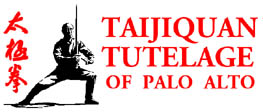
| Press the "Back" button on your web browser to return to the previous page. |

|
(The following is an abstract from Tung Ying-chieh’s Taichichuan Explained, 1948, p. 73. It is presented here as translated by Wu Ta-yeh and Wu Teng Shu-hsien)
"In a forward posture when the front leg is bent, some persons consider the front leg firm (Yang) and the rear leg light (Yin). This is wrong. Try to stand with your front leg firm and your rear leg light, and hit your opponent with a fist or palm. Can you stand stably? Is your attack effective?
"People now regard Taichichuan as an exercise and neglect its self-defense implications. It is only if you learn the posture correctly and do them in accordance to the purpose that you get the real benefits.
"In a stable posture, when both legs support your weight, neither foot should be light. If there is any difference, the rear leg may be firmer in most cases, with the front foot lighter.
"This is so because strength starts from the rear foot. It is only after the front toes are turned sidewise to prepare for a forward step that the front leg becomes real firm.
"This firmness of the two legs changes continuously . When a leg is light, the strength applied there varies between 50% and 20-30%. When it is firm, it may be 80-90%. If you do not apply any strength on a foot, the foot will not follow your mind. If you apply too much strength, it is stagnant."
TRANSLATORS’ NOTE: In a forward stance, although both legs are not "light," the nature of the strength applied at each leg is not the same.
The rear leg serves as a pillar to generate the forward pressure and the front leg serves as a brake.
When strength is applied in this way, you can easily add strength to stretch the rear leg to twist the hip and pivot out the front foot on its heel, provided that the front knee is not bent too much forward.
If the main strength is at the front leg, you will not be able to smoothly turn out the front toes unless you shift back most of your body weight to the rear leg. This reduces your agility and the smoothness of your continuous movement.
You should distinguish between the distribution to the two feet of the static body weight from gravity and the dynamic strength applied at the two legs.
In terms of the static body weight from gravity, the front foot bears a larger proportion of the body weight if you stand limply in the forward posture, without applying strength at either leg.
In terms of dynamic force, which is the essence of Taichichuan, a larger strength is applied at the rear leg in this stance when a palm is pressed forward with continuous energy.
In Taichichuan, neither foot is void of strength. Even when you stand on one foot and move the other foot around, the moving foot is not "void." You apply sufficient strength to guide its movement on a preconceived path.
When a foot is hung in the air, as in the posture "Golden Cock Stands on One Leg," or "Separate Foot," you also apply strength at it to maintain the energy balance in order to achieve physical balance and stability.